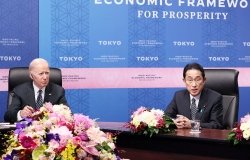First Annual North American Energy Forum: Energy Infrastructure Futures
From widespread fears about energy security, the debate in the United States in recent years has shifted to how the abundance of natural gas and significant new oil reserves are fundamentally altering the U.S. energy relationship with the world. North American energy independence is rapidly becoming a reality, with the United States now confident that it will be able to satisfy declining national demand for oil through a combination of domestic, Canadian, and Mexican supply, fuel efficiency measures, and a long-term shift from gasoline and diesel to natural gas-based fuel for transportation.
Overview
First Annual North American Energy Forum: Energy Infrastructure Futures
The Takeaways
• Whether it is a shortage of pipelines in Alberta, LNG facilities in the United States, or refineries in Mexico, the nations of North America could hugely benefit from increased investment in energy infrastructure. Alberta requires more manpower and more transportation corridors to ensure it gets the best value for its oil; the United States needs infrastructure that reflects the shale revolution and the corresponding export opportunities; Mexico needs to revitalize a stagnating energy sector with increasingly sophisticated facilities.
• Infrastructure is critical to competitiveness. A boom in energy-intensive manufacturing in the United States can be largely attributed to the low energy prices Americans pay, made possible by gas and electricity infrastructure. Mexico, despite its lower labor costs, is losing competitiveness to its northern neighbor due to the high cost of electricity its manufacturers face, a problem spawned by insufficient transmission capacity.
• Energy infrastructure underpins a new global trade dynamic. As non-OECD companies ramp up consumption of fossil fuels, the United States is in the envious position of having energy to spare, so long as it can construct the necessary infrastructure. Improvements in Mexican infrastructure will allow it to alter its import demands, improving its manufacturing sector and altering its trade relationship with the United States. Geopolitically, an increase in the export capacity of Canada and the United States will allow Europe to displace some imports from Russia.
The Outlook for the Region
Rachel Bronson, a senior fellow of global energy at the Chicago Council on Global Affairs, opened the discussion by noting how rapid change in worldwide supply and demand is radically restructuring the global energy market. OECD countries are no longer monopolizing energy consumption, as the developing, non-OECD countries fuel demand. Getting energy from supplier to consumer remains a major hurdle, as everywhere in the world it is difficult to construct new infrastructure projects – the delays and opposition to the Keystone XL pipeline are not anomalous in that regard. While capital shortages drive many of these problems, NIMBYism (not-in-my-backyard) is also causing major delays. The public does not trust energy companies – surveys regularly rank them at or near the bottom of lists of trusted entities. Companies looking to the bridge the gap in public confidence must be willing to do so at a local level. Bronson concluded by reiterating the need for a continental energy strategy, matching the supplies to the demands of Canada, America, and Mexico. During the Q&A, Bronson noted that more and more diplomatic work was being done state-to-state or province-to-province, which is proving to be a significantly faster route than waiting for negotiations between federal governments to conclude.
Antonio Rojas, former comptroller of the Ministry of Energy of Mexico, began by discussing the major shortcomings in the Mexican energy industry. Rojas stated that PEMEX, the Mexican state-owned oil company, lacks the capital to invest in new, expensive infrastructure projects, problematic given that it may need to increase its infrastructure capacity by as much as 50%. The biggest problem, however, is the lack of skilled petroleum engineers in Mexico; Mexico needs to recruit international help to exploit many of its more technically-complex oil plays. Reforms to the Mexican energy sector could have massive benefits to the Mexican economy. By 2025, improvements to the energy sector could lead to the creation 2.5-5 million new jobs, which will lead to a higher standard of living, increased demand for American products, and a decrease in illegal migration across the northern border. Improvements to the energy infrastructure of Mexico will likely lead to a significant decrease in the price of energy, which is unusually high in Mexico. This will increase the competitiveness of the Mexican manufacturing sector, which presently has difficulty competing with the United States in energy-intensive manufacturing, and allow the Mexican government to reduce or eliminate the electricity subsidy, shoring up public finances. If the investment in the shale industry goes according to plan, Rojas concluded, the Mexican economic boom could put its economy on par with Spain’s. During the Q&A, Rojas noted that the falling price of oil worldwide was unlikely to stymie infrastructure development in Mexico, as most of these projects were aimed at domestic, not global, consumers.
Rob Merrifield, the senior representative to the United States from the Government of Alberta, began by noting that, by GDP, Canada is the world’s largest energy-independent country. Merrifield criticized the discourse regarding the Keystone XL debate, saying politicized noise was drowning out the State Department’s own assessment that Keystone will reduce GHGs and is safer than many alternatives. Merrifield noted that Alberta was the first jurisdiction in North America to implement a carbon tax, which he said was supported by the public because it was not used for wealth redistribution but was reinvested in a fund for environmental protection. Merrifield praised the close cooperation between Alberta and Texas, stating that engineering advancements made in one region tended to very quickly be shared with the other. Merrifield concluded by noting that the industry itself was sharing technological advancements in environmental technology, ensuring the best engineering and safest practices were available to all in the industry. During the Q&A Merrifield discussed the significant manpower shortages the Albertan oil projects face, stating that the shortage was difficult to fill as even the United States lacks huge numbers of readily-available petroleum engineers.
North American Oil and Gas Futures
Shirley Neff, speaking on behalf of the Energy Information Administration (EIA), began by noting that in the coming years the two largest non-OPEC sources of growth in energy production would be Canada and Mexico, with expected reforms to the Mexican state-owned oil company PEMEX contributing significantly to this uptick. Neff noted that while there is extensive cross-border electricity and natural gas infrastructure between the United States and Mexico there is only one oil pipeline, which is inadequate for the expected increases in production. Neff also noted that while America’s natural gas infrastructure was designed to pipe gas from the Gulf of Mexico to the Northeast region, new shale plays in New England means that the direction of the flow may soon be reversed. The construction of new energy infrastructure projects worldwide reflects the surge of natural gas production, with the building of liquefaction plants along the East and Gulf Coasts of America and corresponding regasification facilities under construction across South America, creating a new energy trade dynamic. The expansion of the Panama Canal, according to representatives from the Canal Authority, means that all but the largest LNG tankers will soon be able to transit the Canal, potentially opening up huge swathes of Asia to natural gas exports from eastern America.
Ken Hughes, a former Member of Parliament and Minister of Energy for Alberta, began by providing some historical context: while the oil sands of Alberta had no value except as moose pastures thirty years ago, today they are the third-most valuable oil fields in the world, behind only Saudi Arabia and Venezuela. Hughes reiterated the importance of the Albertan oil sands to the Canadian economy, noting they contribute around 80% of Canadian oil, and that about 80% of oil from Alberta comes from the oil sands. Alberta’s biggest concern is ensuring its oil receives the best price possible on the global market, which requires access to tidewater, through pipelines and tankers. The market, seeking to optimize the price of extracted Albertan oil, met these needs by financing the construction of extensive rail networks to facilitate oil-by-rail. Hughes noted that from an economic perspective increased storage and transport capacity translates to increased value for the oil, as sellers are better able to find optimum market conditions to sell in. Hughes concluded by noting that oil from Alberta is beginning to displace Russian natural gas in Europe, which is geopolitically beneficial.
Jordy Herrera, a former Mexican Energy Secretary, began by noting that capital shortages are the biggest challenge the Mexican energy industry faces. A previous glut of oil has been exhausted, and Mexico is struggling to find replacements and supplement the tax revenue they previously received – oil revenue is approximately 1/3 of the Mexican government’s revenue. Projects underway across Mexico to increase production could see the country increase its production from 2.5 to 4.5-5 million barrels per day. Mexico still has to import a large share of refined petroleum products, but for the first time it has the capital to invest in local refineries, thus altering its import needs. Herrera noted that given the surge of energy production within the United States, Mexico can no longer rely on exporting solely to its northern neighbor. It is thus necessary for Mexico to find new trade partners, which will require a lot of diplomatic legwork. Herrera also stressed that, regarding the drug cartels, Mexico is not a country at war, and that the cartels would not deter foreign investment.
North American Electricity Futures
John Renehan, director of strategy at General Electric Power and Energy, opened the panel by stating that GE predicted that natural gas equipment would be responsible for almost 50% of the demand for new energy equipment in the coming years, with wind turbines the next largest source at around 25%. Renehan noted the benefits of cheaper energy prices in North America, stating that European manufacturers are beginning to relocate to the United States due to its price competitiveness. Speaking to the future, Renehan reiterated GE’s prediction that North American energy production will grow by 215 gigawatts by 2023. The cost of renewable energy is plummeting, and given that we spend $3 trillion/year on electricity, every improvement to efficiency has huge repercussions. Renehan concluded by predicting that high-capacity batteries will be hugely disruptive in the coming years, and will allow the renewable energy sector to boom as never before.
Mexican Under-Secretary for Electricity César Hernández noted that many attributed the stagnation of the Mexican energy and electricity sectors to the fact that they were some of the last sectors closed off to foreign investment or participation. Hernández credited NAFTA with forcing many reforms in Mexico, and fueling a boom in Mexican manufacturing. That manufacturing, Hernández noted, is presently in danger, as Mexico’s high electricity prices are pushing energy-intensive manufacturers to move north.
Speakers:
David Biette, Director, Canada Institute, Wilson Center
Rachel Bronson, Senior Fellow, Global Energy, Chicago Council on Global Affairs
Andrew Finn, Associate, Canada Institute, Wilson Center
César Hernández, Under-Secretary for Electricity, Mexico
Jordy Herrera, former Mexican Energy Secretary
Ken Hughes, former Alberta Energy Minister
John Renehan, Director of Strategy, GE Power and Energy
Hon. Rob Merrifield, P.C., Senior Representative to the United States of America for the Government of Alberta
Antonio Rojas, former Comptroller of the Ministry of Energy, the Energy Regulatory Commission (CRE), the National Hydrocarbons Commission (CNH) and the National Commission for Energy Efficiency (CONUEE)
Shirley Neff, Senior Advisor, U.S. Energy Information Administration
Duncan Wood, Director, Mexico Institute, Wilson Center
Hosted By

Canada Institute
The mission of the Wilson Center's Canada Institute is to raise the level of knowledge of Canada in the United States, particularly within the Washington, DC policy community. Research projects, initiatives, podcasts, and publications cover contemporary Canada, US-Canadian relations, North American political economy, and Canada's global role as it intersects with US national interests. Read more

Mexico Institute
The Mexico Institute seeks to improve understanding, communication, and cooperation between Mexico and the United States by promoting original research, encouraging public discussion, and proposing policy options for enhancing the bilateral relationship. A binational Advisory Board, chaired by Luis Téllez and Earl Anthony Wayne, oversees the work of the Mexico Institute. Read more
Thank you for your interest in this event. Please send any feedback or questions to our Events staff.










